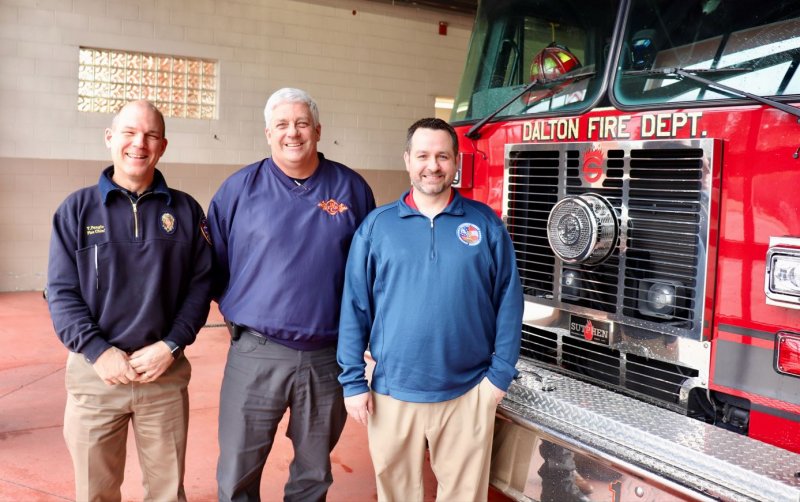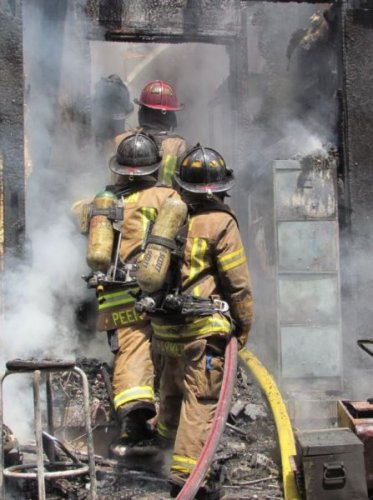Could It Happen Here? Local Public Safety Leaders React To Ohio Train Derailment
 Monday, February 20th, 2023
Monday, February 20th, 2023
After news spread of a February 3rd train derailment near East Palestine, Ohio resulting in a fire that released dangerous chemicals into the environment, many residents in the Dalton area wondered if the same thing could happen here. With two major railroads passing through the community as well as I-75 and state highways, the possibility of an accident is always present, but local public safety agencies are trained and prepared to respond if it happens.
"We've got some dangerous stuff that comes through here," said Todd Pangle, the City of Dalton's fire chief. "It’s one of those things that I take seriously, I’ve got 33, 34,000 people as residents of this city and I feel it’s my job to be as prepared to protect them as we can."
Caption: Chiefs Todd Pangle (Dalton Fire) and Ed O'Brien (Whitfield County Fire) and David Metcalf (Whitfield County Emergency Management Agency) pose together after a recent meeting at DFD's Station 1 (courtesy Whitfield County PIO Valeria Molina)
Chief Pangle recently hosted a meeting with his counterpart from the Whitfield County Fire Department, Chief Ed O'Brien and officials from the Whitfield County and Georgia Emergency Management Agencies to discuss preparedness for these types of events with public information staff from the two local governments. The message: while Dalton and Whitfield County may be small communities, they've got big-time public safety agencies that are prepared for this type of event. There's a plan.
"We’re always working on (preparedness)," Chief O'Brien said. "There is so much pre-planning that we do where we look at the businesses that we have, seeing what we have coming in on the rails or on the road to be prepared... for hazardous materials, there are three levels of certification through the state. You have hazmat awareness level, hazmat operations level, and the highest certification is hazmat technician. All of the county firefighters are at the ops level and we have ten or twelve technicians. We maintain that annually,"
"We have eight (hazmat technicians) per shift with the city," said Chief Pangle. "24 technicians among the three work shifts, and we have two others that work a five-day work week. We have a designated hazmat team and we require our team to train together at least once a quarter so that we exceed the required amount of training (required by the state of Georgia). That way, we're getting our hazmat stuff out, we're rotating our stock and different things like that."
"It's an expensive venture to do that, and that's why we're very blessed to have what the city has given us," Chief Pangle added. "If you think about a Level A hazmat suit, well, some of the Level A suits are only good for certain chemicals and then you have flash suits and different things like that. So we have a lot of very expensive equipment that unfortunately sometimes doesn’t even get used before its shelf life expires. We’re as prepared as we can be with that, and we do commit a lot of hours annually to keep our technicians up on their training – because technicians are required to do even more training every year."
Chief Pangle noted that one reason his department doesn't have more firefighters trained to the technician level is the expense. His agency spends $24,000 each year just for his hazmat technicians to receive the extensive annual physicals that are required by the state for their certification.
The Dalton Fire Department maintains extensive equipment and supplies for hazmat situations. Whitfield County's fire department also has a supply of equipment and can also call on Dalton or other local and state agencies to assist through mutual aid when the need arises.
"If we need equipment, we can get anything we need in this county quickly," Chief O'Brien said.
The close working relationships that the leaders of the two fire departments as well as the other local public safety and emergency management agencies maintain is one of the biggest strengths the community has when disaster strikes. Those relationships are built through not just working closely day to day at incident scenes, but also through the frequent meetings of Whitfield County's Local Emergency Planning Committee (LEPC). The LEPC meets bi-monthly with representatives from each local police or fire agency as well as the Whitfield County Emergency Management Agency (WCEMA) and Georgia Emergency Management Agency (GEMA). Safety personnel and managers from local manufacturing businesses also attend the meetings.
"I don’t know how many LEPCs there are in the state that are active, but it’s something to be proud of in this community that our LEPC is so active and it’s not anything to have at least 40 people at one of our meetings from all these companies and the public safety agencies," Chief O'Brien said.
 "We work together almost daily. (WCEMA Director) David (Metcalf) was in my office today, (Chief O’Brien and I) probably talk at least once a day, or a couple times a day," Chief Pangle said. "Through the LEPC, we’re able to network with some of our local manufacturing, and most of our LEPC meetings we’ve got GEMA presence there, so we’re able to put faces with names and we don’t have to wait for something like this to happen because we’ve already fostered the relationships before something like this comes up."
"We work together almost daily. (WCEMA Director) David (Metcalf) was in my office today, (Chief O’Brien and I) probably talk at least once a day, or a couple times a day," Chief Pangle said. "Through the LEPC, we’re able to network with some of our local manufacturing, and most of our LEPC meetings we’ve got GEMA presence there, so we’re able to put faces with names and we don’t have to wait for something like this to happen because we’ve already fostered the relationships before something like this comes up."
"One of the big things that people forget about is that you’ve got the fire department on scene dealing with the hazard, but you’ve got to think about the sheltering and the evacuation and so that’s where emergency management is going ot work with GEMA to provide those resources," WCEMA director David Metcalf said. "We’re going to start reaching out to the Red Cross and whoever we can reach out to start helping with those evacuations and sheltering and getting them in place. I think that was one of the downfalls in Ohio is it just didn’t happen quickly enough."
The local emergency agencies that make up the LEPC plan large scale training exercises together every few years to put their planning to the test. Before the Ohio derailment ever happened, plans were already in the works for Norfolk Southern to bring a training train car to town this spring for firefighters to use in training scenarios. A mock disaster drill involving the railroad is being planned for next year.
Caption: File photo of Dalton firefighters battling a blaze in the city
The LEPC and the local public safety agencies created and continually maintain the Whitfield County Hazard Mitigation Plan. That plan identifies known technological or environmental hazards present in the community and develops strategies to reduce the risks for community residents.
Public safety officials have been watching the story in Ohio unfold closely, just as they do with other disasters around the country, looking for the lessons they can apply to the Whitfield County community's plans.
"When I see something like that happen, my thoughts go to the fact something like that could happen here," Chief Pangle said. "I know that as I was watching and thinking, I was paying particular attention to exactly what kinds of resources they were able to amass and in what time frame they were able to do it... if we have something like that, how quickly can we involve our local EMA as well as the state level EMA, because we have some resources available to us through the CST as well that you definitely would want to get there."
"I’m not saying I want it to happen tomorrow but if it does happen in the city of Dalton I know that I’m surrounded with a bunch of support," Chief Pangle said, with agreement from all of the other public safety leaders in the room.
